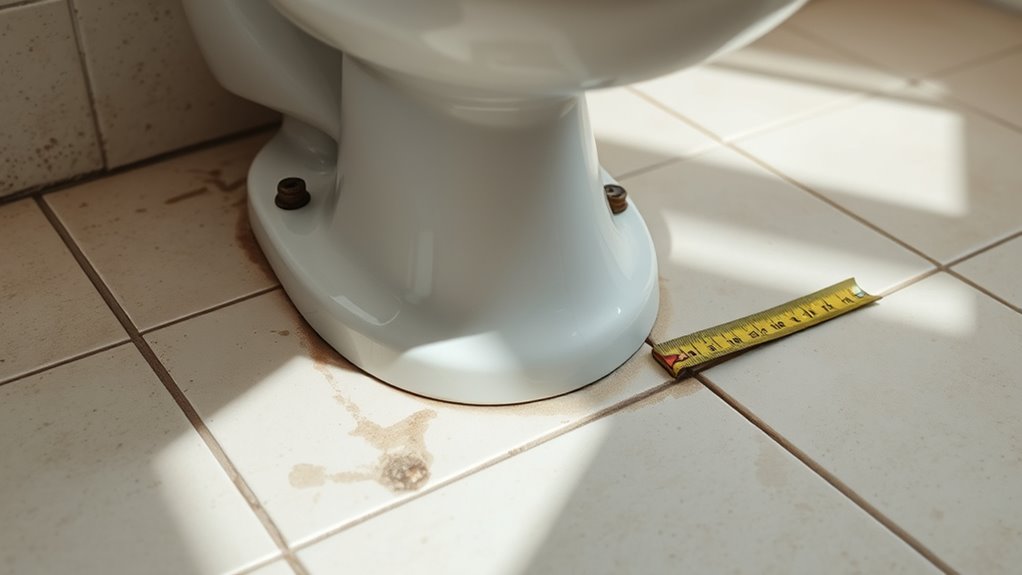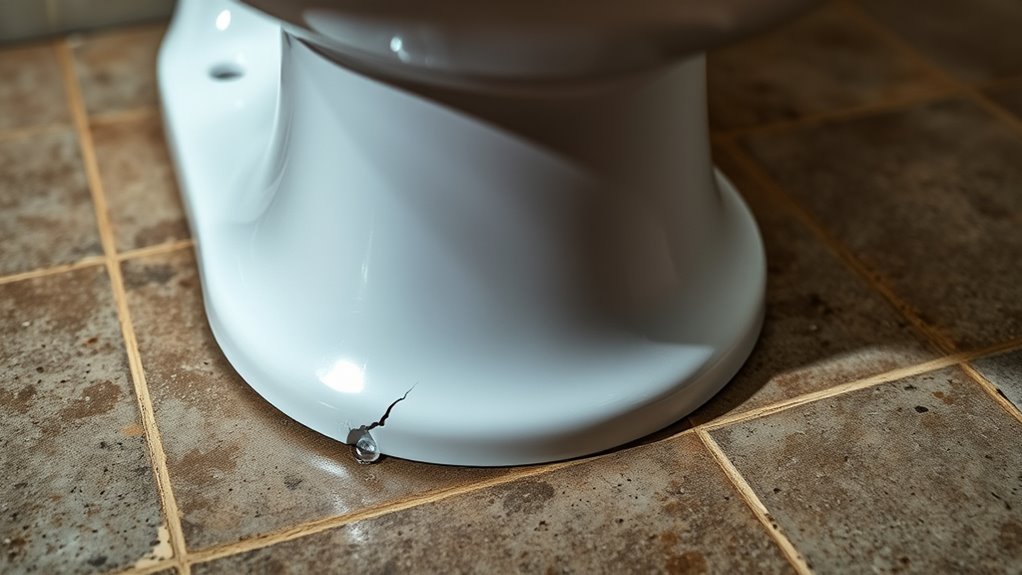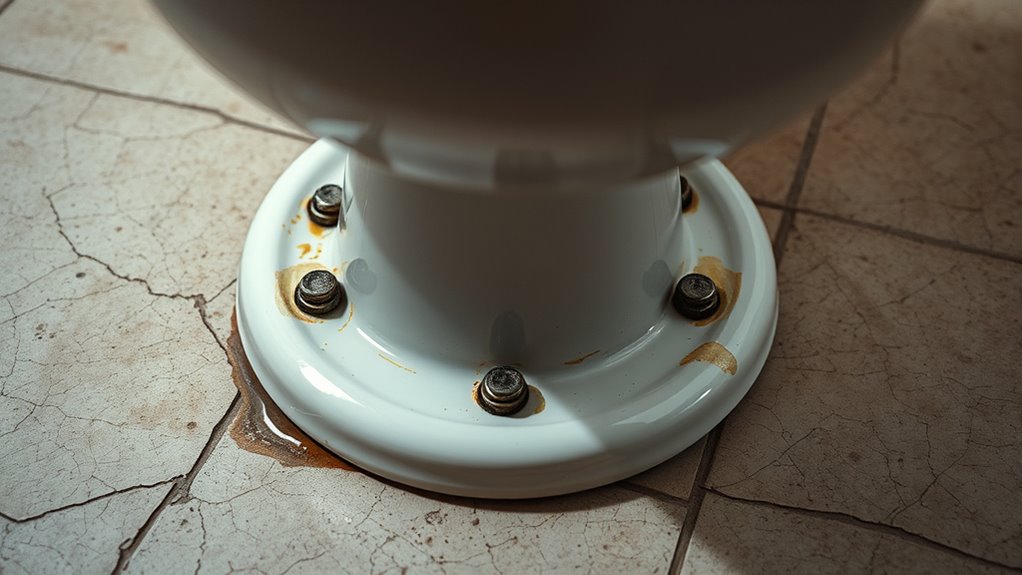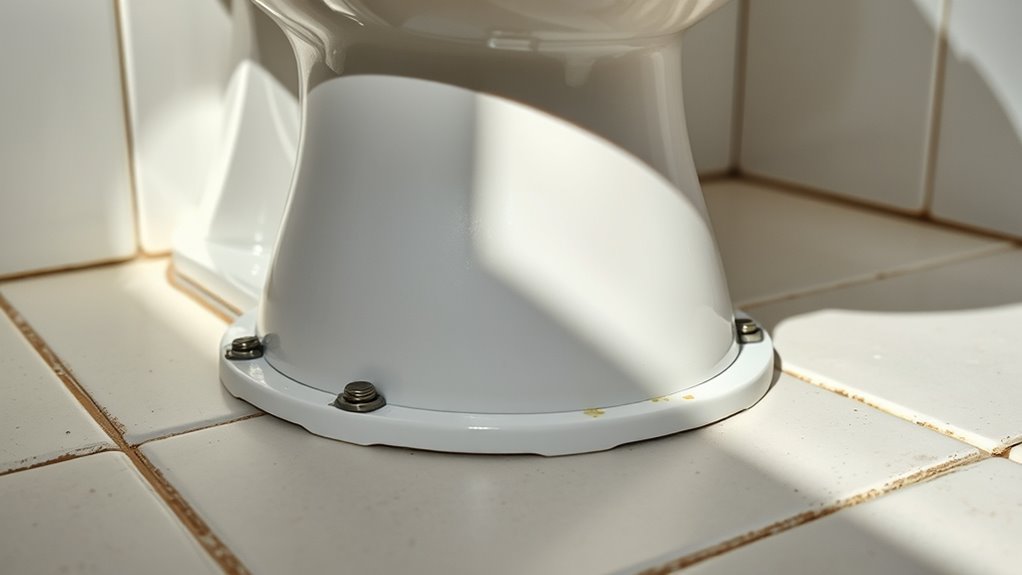Your toilet is loose on the floor because its mounting bolts may have loosened, the wax ring seal could be damaged, or the bathroom floor might be uneven or compromised. Corroded or improperly installed bolts also contribute to instability. This wobbling stresses plumbing connections and risks leaks or water damage. To fix it, you’ll need to inspect and possibly replace bolts, check the wax ring, and guarantee the floor and flange are sound. Understanding these causes will help you secure your toilet effectively.
Common Causes of a Loose Toilet

Although a loose toilet may seem minor, it usually indicates issues with the mounting bolts, wax ring seal, or floor stability. You’ll want to inspect these components carefully because they’re critical to your toilet’s secure placement. Over time, mounting bolts can loosen due to regular use or improper installation, while the wax ring may degrade, compromising the seal and causing wobbling. Additionally, if the floor beneath isn’t level or has water damage, the toilet won’t remain stable. For effective toilet maintenance tips, regularly check bolt tightness and replace the wax ring during bathroom renovation ideas to guarantee a solid seal. Addressing these causes promptly lets you regain control and prevents further damage, preserving your bathroom’s functionality and your freedom from unexpected repairs.
Worn or Broken Toilet Bolts
Two main types of bolts secure your toilet to the floor: closet bolts and flange bolts. Over time, these bolts can corrode, loosen, or break, causing your toilet to wobble. Addressing worn or broken toilet bolts promptly is essential for stability and preventing leaks. Follow this bolt replacement guide to restore a firm fixture.
| Bolt Type | Common Issues | Wartungstipps |
|---|---|---|
| Closet Bolts | Rust, stripping | Tighten regularly, replace if corroded |
| Flange Bolts | Breakage, loosening | Inspect flange integrity during replacement |
| Both | Wear over time | Use rust-resistant bolts during installation |
Incorporate these toilet maintenance tips to maintain freedom from leaks and instability, ensuring your toilet stays secure.
Damaged Wax Ring Seal

If your toilet feels loose, the wax ring seal beneath it might be compromised. Look for signs like unpleasant odors, water leaks, or visible gaps around the base. A damaged wax ring can’t maintain a secure seal, which directly affects the toilet’s stability and can cause wobbling.
Wax Ring Deterioration Signs
When the wax ring seal beneath your toilet starts to deteriorate, you’ll often notice specific signs indicating a compromised seal. Recognizing these early helps you avoid bigger issues and maintain your freedom from costly repairs. Here are key wax ring deterioration signs:
- Foul odors near the base of the toilet, signaling sewer gas leakage.
- Moisture pooling around the toilet’s base, indicating a failing wax ring.
- A faint, persistent sound of water running after flushing.
- Slight toilet movement or rocking despite secure bolts, hinting at seal breakdown.
Regular toilet maintenance includes monitoring these signs. Addressing them promptly guarantees the wax ring performs its critical sealing function, preventing leaks and odors that could disrupt your daily routine and comfort.
Impact on Toilet Stability
Although you might not immediately connect a damaged wax ring seal to toilet stability, it plays an essential role in keeping your toilet firmly anchored. The wax ring creates a watertight seal between the toilet base and the flange on the floor, preventing leaks and maintaining consistent pressure. When this seal deteriorates, your toilet can shift or rock, compromising toilet functionality and risking damage to the flange or floor. This instability threatens bathroom safety by increasing the chance of slips or sudden toilet movement during use. To preserve both your freedom of movement and bathroom integrity, promptly inspect and replace a compromised wax ring seal. Doing so guarantees your toilet remains stable, secure, and fully functional, safeguarding your bathroom environment and preventing costly repairs.
Uneven or Damaged Bathroom Floor
Since a toilet is anchored directly to the bathroom floor, any unevenness or damage in the floor can cause instability. Uneven surfaces disrupt the secure contact between the toilet base and the Bodenbelag materials, leading to rocking or loosening over time. You should inspect the floor for:
- Cracked or broken tiles beneath the toilet
- Warped plywood subflooring from water damage
- Uneven concrete slab or floor joists
- Deteriorated or missing underlayment
These issues compromise the toilet’s foundation, making it impossible to create a firm seal with the flange and wax ring. Addressing uneven or damaged flooring guarantees your toilet remains stable and leak-free, giving you the freedom to use your bathroom confidently without worrying about shifting or potential water damage.
Improper Installation Techniques

If your toilet is loose, improper installation techniques could be the culprit. You might have an incorrectly aligned flange, an insufficient wax ring seal, or loose floor bolts. Addressing these issues guarantees a secure and stable toilet setup.
Incorrect Flange Alignment
When the toilet flange isn’t properly aligned during installation, it can cause your toilet to rock or feel loose. The flange must be correctly positioned to guarantee stability and a proper seal. Misalignment often results from incorrect flange height or using the wrong flange type for your flooring. To keep your toilet solid, consider these factors:
- Flange sits flush with or slightly above finished floor level
- Flange type matches your drainpipe and flooring material
- Flange bolts aligned perfectly with toilet base holes
- Secure flange mounting to subfloor without gaps or movement
Insufficient Wax Ring Seal
One common cause of a loose toilet is an insufficient wax ring seal caused by improper installation techniques. If the wax ring materials aren’t correctly chosen or positioned, the seal won’t hold, allowing movement and leaks. When installing, guarantee the wax ring fully covers the flange and is compressed evenly as you set the toilet. Avoid reusing old wax rings; always replace them with new, quality materials designed for your flange height. Pressing the toilet down too forcefully or at an angle can break the seal, so lower it straight and apply steady pressure. Follow precise installation tips: check flange condition, align bolt holes, and confirm the wax ring isn’t damaged before seating the toilet. Proper sealing frees you from leaks and instability.
Loose Floor Bolts
Properly sealing the wax ring is only part of securing your toilet; loose floor bolts can also cause instability and movement. If those bolts weren’t tightened correctly during installation, your toilet won’t stay anchored. Over time, vibrations and use can loosen them further. To maintain freedom from leaks and wobbling, you need to inspect and adjust the bolts regularly. Here are key considerations:
- Check bolt tightness with a wrench, avoiding overtightening
- Replace corroded or stripped bolts promptly
- Use a level to verify toilet stability after tightening
- Explore floor repair options if bolt holes are damaged or enlarged
Incorporating these toilet maintenance tips will keep your fixture secure and prevent costly damage to your bathroom floor.
Corroded or Rusted Fasteners
Fasteners like bolts and screws can corrode or rust over time, especially in moist bathroom environments, compromising the stability of your toilet. When fasteners deteriorate, they lose their grip, causing your toilet to wobble or loosen from the floor. To maintain freedom from leaks or damage, regular inspections and rust prevention are vital.
| Rust Prevention | Wartungstipps |
|---|---|
| Use stainless steel bolts | Inspect fasteners biannually |
| Apply rust-resistant coatings | Tighten bolts carefully to avoid stripping |
| Keep area dry and ventilated | Replace corroded fasteners immediately |
| Avoid over-tightening to prevent damage | Use anti-seize lubricant on threads |
Following these steps helps guarantee your toilet remains firmly anchored, preserving both function and safety.
Effects of a Loose Toilet on Plumbing
When your toilet’s bolts or screws corrode and loosen, it doesn’t just affect stability—it can compromise your entire plumbing system. A loose toilet creates gaps that allow movement, putting stress on plumbing seals and joints. This stress often leads to:
- Plumbing leaks around the base, causing persistent water exposure
- Gradual water damage to subflooring and bathroom flooring materials
- Deterioration of wax rings, weakening the toilet-to-drain seal
- Increased risk of pipe misalignment, reducing system efficiency
Ignoring these issues limits your bathroom’s functionality and freedom from costly repairs. Addressing a loose toilet promptly preserves the integrity of your plumbing system and prevents the silent spread of water damage beneath your floor.
How to Diagnose the Problem
How can you tell if your toilet is truly loose or if the issue lies elsewhere? Start by applying gentle pressure to the toilet bowl’s sides. If it rocks or shifts, the base is loose. Check for visible gaps between the floor and the toilet base. Next, inspect the mounting bolts for corrosion or looseness using basic plumbing troubleshooting techniques. Also, look for water damage or soft flooring around the base, which may indicate structural problems rather than just a loose toilet. Use a level to confirm if the toilet is sitting evenly. These toilet maintenance tips help pinpoint whether the problem stems from mounting hardware, wax ring failure, or subfloor issues. Precise diagnosis prevents unnecessary repairs and preserves your bathroom’s freedom from leaks or further damage.
Steps to Secure a Loose Toilet
After identifying that your toilet is loose and determining the cause, securing it properly is the next step. Follow these bathroom repair essentials to restore stability:
- Turn off the water supply and drain the tank to prevent leaks.
- Remove the toilet carefully and inspect the flange for damage or misalignment.
- Replace or install a new wax ring to guarantee a tight seal between the toilet base and flange.
- Reposition the toilet, tighten the bolts evenly, and check for wobbling to finalize stability.
These toilet maintenance tips will help you maintain freedom from future issues and guarantee your toilet is firmly anchored. Properly securing the toilet not only prevents damage but also enhances safety and hygiene in your bathroom space.




